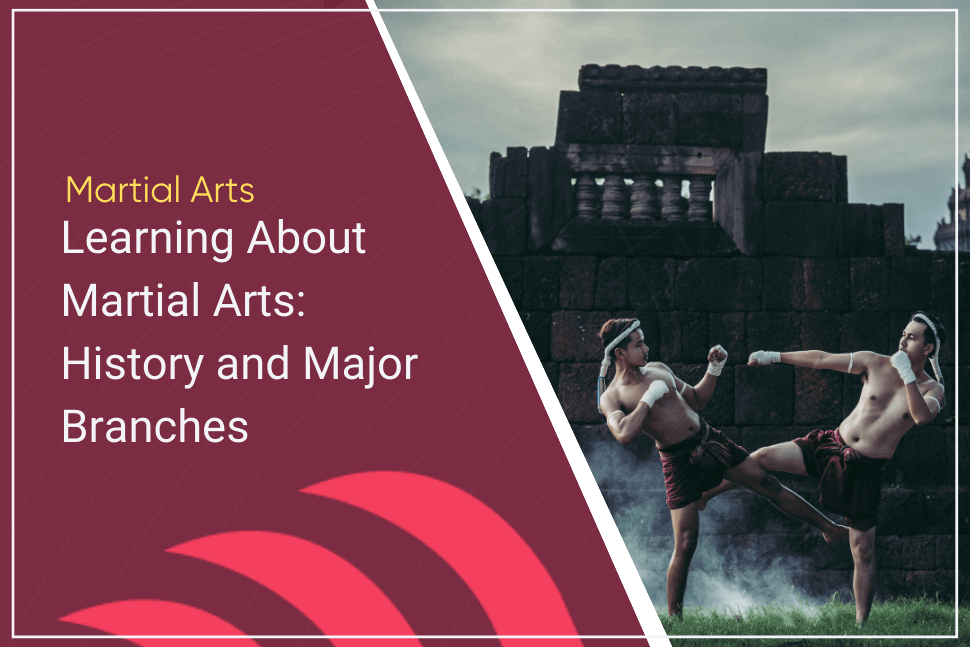Martial arts are more than a sport. They’re truly captivating, given the extensive array of disciplines and unique cultural philosophies each one embodies. The sheer number of different types of martial arts ensures that anyone can find a discipline that resonates with their interests, goals, and personal inclinations.
What is Martial Arts?
Martial arts refer to a broad range of traditional and modern combat practices and systems. The approaches are rooted in cultures and philosophies from around the world. They are practiced for a variety of purposes, including self-defense, mental wellness, and competition.
Martial arts encompass countless styles and disciplines, each with its own unique techniques, principles, and cultural backgrounds. Martial artists employ several different styles of striking and grappling techniques, as well as weapons training or a combination of the two.
While martial arts involve physical combat, they often also embody philosophical and moral principles that promote values such as discipline, respect, humility, perseverance, and self-control. Martial arts training is a holistic approach to human wellness.
Where did Martial Arts Originate?
Answering the question of who invited martial arts is tricky. Martial arts originated all over the world. Different civilizations have developed their own unique combat systems. Many of the world’s most well-known martial arts originated in Asia, including Kung Fu, Karate, Judo, Aikido, and Muay Thai.
It’s important to note that martial arts have evolved and spread through cultural exchange, migration, and historical interactions between regions. Different martial arts styles have influenced and borrowed from one another, leading to a rich diversity.
When did Martial Arts Start?
Martial arts history shows us that they have likely existed for as long as human civilization itself. Archaeological evidence, historical records, and oral traditions indicate fighting systems dating back to 1500 BC. Throughout history, people have needed a way to engage in combat for defense.
Kalaripayattu is an ancient Indian martial art believed to be one of the oldest recorded fighting systems encompassing strikes, kicks, grappling, and weaponry defenses. Over the centuries, Kalaripayattu has influenced and contributed to the development of other martial arts. The beauty of martial arts is the absorption and adaptation of different cultural perspectives into new disciplines.
What are the Components of Martial Arts?
Martial arts encompass several key components that contribute to the overall success of a martial artist. These key components include equipment, techniques, and training methods. Here’s a breakdown of each component.
- Equipment: Equipment includes protective gear and training aids. Protective items often include gloves, hand wraps, mouthguards, shin guards, headgear, and groin protectors, which help minimize the risk of injury. Training aids such as punching bags, focus mitts, kicking shields, dummies, and weapon replicas enhance proficiency.
- Techniques: Martial arts techniques vary widely depending on style. Techniques range from striking, grappling, throwing, joint locks, submissions, and defensive maneuvers. Each discipline has its own repertoire of techniques, including combinations and strategies.
- Training methods: Martial arts training methods are designed to develop skill acquisition, physical conditioning, and mental discipline. Training methods vary greatly across different martial arts styles, but most include forms, sparring, drills, conditioning exercises, and mental control.
It’s important to note that each martial art has its own intricate combination of equipment, techniques, and training methods specifically tailored to the discipline’s philosophies, objectives, and cultural backgrounds.
What are the Fitness components Needed for Martial Arts?
Various fitness components play a crucial role in supporting a martial artist’s overall performance and physical capabilities. Cardiovascular endurance is an essential component given that martial arts training is physically demanding, often faced-past, and requires bursts of energy.
Strength and power are fundamental fitness components for executing strikes, blocks, grappling maneuvers, and overall technique effectiveness. Strong muscles generate force and deliver techniques with power; however, they also require oxygen and blood flow which can lead to fatigue.
Flexibility, speed, and agility are also key fitness components needed for martial arts. When engaging in physical battles, quick reaction times, rapid movement, and the ability to evade attacks are requirements. Martial arts are a physically demanding activity with a dynamic set of fitness requirements.
What are the Different Categories of Martial Arts?
Martial arts have evolved and diversified over many years. Different regions and cultures have developed their own unique systems and approaches to combat and self-defense. It’s estimated that there are thousands of distinct styles; however, the categories can be broken down into six different categories.
1. Japanese
Japan is renowned for martial arts with deep historical roots and cultural significance. The first noted form of Japanese-style martial arts is believed to be “Koryu,” referring to a collection of martial arts styles and systems developed in Japan prior to the Meiji Restoration in 1868.
Modern Japanese martial arts styles include Karate, Judo, Aikido, and Kendo. While Karate and Aikido take a standup approach to fighting utilizing punches, kicks, and throws, Judo is a grappling-based defense system. Kendo martial artists use bamboo swords called shinai.
2. MMA
The development of Mixed Martial Arts (MMA) happened in the 1990s in a quest to determine which is the best martial art. MMA itself is a combat sport incorporating various martial arts disciplines with no distinct “style.”
MMA fighters deliver a melting pot of fighting styles rooted in specific martial arts disciplines. Some fighters focus on striking, emphasizing Muay Thai or another kickboxing style. At the same time, some excel in grappling and submissions employing techniques from Brazilian Jiu-Jitsu. Each fighter generally favors a particular aspect of the sport based on their background.
3. Korean
The origins of Korean martial arts can be traced back to ancient times. Throughout history, several Korean martial arts styles have emerged with influences from China and Buddhist warrior monks. Two prominent disciplines today include Taekwondo and Hapkido.
Taekwondo is a globally recognized Korean self-defense. It combines fast-paced striking movements and emphasizes mental fortitude. Hapkido, on the other hand, uses redirection of an opponent’s energy to leverage motion rather than brute force.
4. Chinese
Chinese martial arts can be categorized into internal and external styles. Internal styles, such as Tai Chi, focus on achieving an inner state of relaxation and flowing movements. Tai Chi is known for its health benefits, meditation in motion, and self-defense applications.
Kung Fu is an external martial arts style utilizing physical strength, speed, and explosive movements. It’s important to note that there are several subsets of Kung Fu, but each often involves rigorous training and direct striking combat techniques.
5. Brazilian
Brazilian martial arts are known for two distinct styles: Capoeira and Brazilian Jiu-Jitsu. Capoeira incorporates rhythmic and fluid kicks, sweeps, and spins to the beat of live music. It’s known for its deceptive nature of strategic evasions and trickery.
On the other hand, Brazilian Jiu-Jitsu is an effective real-life self-defense strategy popular in modern MMA. BJJ involves grappling techniques that position body control to gain the submission of an opponent. Methods include joint locks, chokeholds, and positioning.
6. Reality-Based Self-Defense
Reality-based self-defense refers to a category of training methods aimed at real-world confrontations. The most well-known form of reality-based self-defense is Krav Maga. Krav Maga is a dynamic system of combat developed for the Israeli military.
Krav Maga emphasizes the importance of situational awareness to quickly apply various broadly applicable techniques. Its techniques prioritize effectiveness over aesthetics. Styles range from striking attacks to grappling control and defensive movements.
What are the Different Types of Martial Arts?
There are endless styles of fighting. To consider all martial arts would leave you with hundreds, if not thousands, of options. Instead of specific disciplines, when considering what is the best martial art, break the options down into types or approaches to defense. In that regard, there are three distinct types of martial arts.
Striking
Striking martial arts, also called standup, focus on executing techniques with both combatants standing. Common standup includes Karate, Taekwondo, Muay Thai, and Kung Fu, though many others also exist.
Striking martial arts coordinate hands or fists, feet or shins, and elbows or knees to launch attacks and pose defenses. Strikers develop their craft through focus, coordination, and body positioning. They create speed and accuracy through footwork fundamentals and a constant distance assessment.
Grappling
Grappling martial arts focus on techniques that involve close-quarters combat. Grapplers control an opponent and gain advantageous body positions on the ground. Common grappling styles include Brazilian Jiu-Jitsu, Judo, Sambo, and wrestling.
Groundwork involves manipulating an opponent’s body position to restrict their movements while executing submissions. Grappling can also include standing clinches, throws, and takedowns to force the battle to the floor. Grapplers neutralize threats and subdue opponents outside of striking attacks.
Hybrids
Hybrid martial arts refer to styles that incorporate both striking and grappling tactics. These martial arts combine elements from multiple disciplines to create well-rounded martial artists. MMA, Jeet Kune Do, and Krav Maga are all examples of hybrid fighting styles.
Hybrid styles produce outstanding displays of athleticism. Full-contact combat sports, such as MMA, allow fighters to swiftly and efficiently change the course of the fight from standing to groundwork. The hybrid martial arts approach incorporates many tactics, such as punches, kicks, throws, takedowns, clinches, and submissions.
How to Choose What Martial Arts to Learn?
Consider several factors when deciding which martial arts is best for you. You’ll need to determine your goals and interests as different disciplines focus more or less on aspects of self-defense, physical fitness, cultural exploration, or personal development.
Research and explore martial arts styles like Kung Fu vs. Karate or Brazilian Jiu-Jitsu vs. Muay Thai. Each style has its own techniques, philosophies, and approaches to training. For example, when considering Karate vs. Kung Fu, the training methods focus on two very different strategies to combat.
You’ll also need to assess your own physical capabilities, including fitness level and any specific limitations. Some martial arts styles are more physically demanding or require the use of particular body parts, flexibility, and strength.
Lastly, evaluate instructors and schools. Find a reputable gym with qualified coaches who align with your values, goals, and objectives. Visit different schools, observe classes, and speak with instructors to gauge the overall learning environment. If a free course is offered, take it before signing a contract.
Frequently Asked Questions About Learning Martial Arts
The vast world of martial arts leads to many considerations. Whether you’re curious about the deadliest martial arts, how many martial arts there are, or which is best for you, there are sure to be questions. Here are some answers and insights into people’s everyday concerns when pondering “which martial art is the best for me.”
What are the Martial Arts Utilizing Weapons?
Kendo, fencing, eskrima, kali, and arnis are the most popular martial arts, exclusively utilizing weapons. Though not a traditional aspect of Taekwondo, Hapkido, or Kung Fu, many of these schools also incorporate weaponry elements in training methods.
As most martial arts have developed over time and influence, several Taekwondo and Hapkido dojangs may occasionally train students with canes, short sticks, or wooden swords as supplemental defense components.
What is the Importance of Learning Martial Arts?
The importance of learning martial arts is in the pursuit. All martial arts share common benefits, including self-defense, physical fitness, character development, and lifelong learning. Despite goals varying from person to person, these shared beliefs hold the same value.
Martial arts embrace continuous learning and self-improvement, noting that there is always something new to discover. Even martial artists with decades of experience understand that mastery is a lifelong pursuit, and sometimes a beginner can awaken a unique experience for them.
How to Start Learning Martial Arts?
Starting martial arts is an exciting journey requiring commitment, discipline, and perseverance. Start with a beginner class introducing fundamental techniques and concepts in a safe environment. Embrace the learning process with a willingness to learn, respecting the guidance provided.
Set realistic goals and practice regularly. Understand that skill development and progression take time, but consistency always pays off. Embracing the martial arts lifestyle by respecting coaches and peers welcomes you into an encouraging community that will help you achieve your desired outcomes.
Can I Learn Martial Arts on My Own?
Yes, it’s possible to learn some aspects of martial arts on your own. However, under professional guidance, you’ll learn proper technique and form that leads to safer execution and maximized effectiveness.
Bad habits developed in self-training often lead to incorrect form and injury. Martial arts involve physical contact and complex movements, so having an instructor present ensures safe training and progression.
Where Can I Learn Martial Arts?
Martial arts schools, training centers, dojos, and academies are the best places to learn martial arts. Other venues, such as online resources, can introduce a martial arts discipline to you, but they can’t replace in-person training.
A dedicated martial arts school specifically focuses on teaching a disciplined style. These schools offer structured programs, qualified instructors, and a supportive training environment, including opportunities to engage in drilling or sparring.
Does the Gym Offer Martial Arts Classes?
Yes, certain gyms do offer martial arts classes. UFC Gym is a franchise fitness center providing a wide range of martial arts classes, including MMA, Brazilian Jiu-Jitsu, Muay Thai, and boxing. Additionally, 24-hour fitness is another chain gym offering classes for various martial arts styles.
It’s important to note that many franchised gyms often focus on the fitness application of martial arts and under-emphasize the traditional aspects of the available styles. For example, respect is an essential element taught in Muay Thai schools. You likely won’t learn Kuen Khru in a chain gym setting.
What are the Benefits of Learning Martial Arts?
Learning martial arts offers a comprehensive set of benefits. These include improvements in the physical, mental, and emotional aspects of well-being. Here are a few key benefits of learning martial arts:
- Physical Fitness: Martial arts training improves cardiovascular health, strength, flexibility, agility, and coordination to improve overall fitness.
- Self-Defense: Effectively learn techniques that improve your ability to protect yourself and control threatening situations.
- Confidence: Mastering new skills and nailing proper techniques help develop a sense of achievement and enhance self-confidence.
- Mental Resilience: Learning to overcome challenges and persevere through difficult situations develops a mental toughness that translates to other aspects of life.
- Supportive Community: The martial arts community is full of supportive teammates cheering each other on to new heights of success.
The benefits of all martial arts provide a valuable and rewarding pursuit for people of all ages and backgrounds. Whether you’re seeking to improve fitness or mental toughness, martial arts training is a holistic approach to self-improvement.
Are there Disadvantages to Learning Martial Arts?
There are potential disadvantages to learning martial arts. It’s important to be aware of these factors and consider them when pursuing martial arts training. Here are a few possible disadvantages:
- Financial Costs: Expenses associated with training can add up. Depending on the style, you may need to purchase equipment, uniforms, and testing fees in addition to a monthly membership.
- Physical Demands: Martial arts training is physically demanding. It requires a level of physical fitness and stamina that can be challenging, especially for beginners or people with pre-existing health conditions.
- Learning Curve: There is a steep learning curve. It takes time to grasp techniques, develop coordination, and progress through the ranks. Patience, persistence, and perseverance are necessary.
- Risk of Injury: Martial arts involve physical contact, so there is always a risk of injury. Techniques, especially during full-speed sparring, can result in physical harm. Proper training and protective gear are essential.
Weighing the potential disadvantages against the benefits will help answer the question, “Which martial art is best for me?” The positive impact and personal growth that martial arts provide often outweigh the potential drawbacks, especially when you choose a reputable school.
Is Martial Arts a Sport?
Yes, martial arts is a sport. Martial arts involve structured training, rules, and competitive elements. Many martial arts styles have evolved into organized sports with specific tournaments, competitions, and ranking systems.
Martial arts competitions focus on showcasing technical skills, physical prowess, and strategic approaches to combat. Competitors aim to score points to achieve victory. However, not everyone involved in martial arts is required to compete. The topic is a conversation between students and coaches.
Is Martial Arts Good for Self-Defense?
Yes, martial arts can be highly effective for self-defense. Many martial arts disciplines focus on the practical application of self-defense tactics in real-world situations. Learning martial arts can provide you with the skills and confidence to protect yourself in dangerous situations.
Also worthy of consideration is that self-defense goes beyond physical techniques. Martial arts training also helps develop situational awareness, conflict avoidance, and ethical issues surrounding physical engagement, which are also important aspects of self-defense.
Is Martial Arts Dangerous?
Martial arts are no more dangerous than other sports. While there are inherent risks involved with full-contact sports, martial arts training is generally safe when practiced under proper guidance and within established safety guidelines.
Reputable schools provide training in a well-supervised and controlled environment following proper techniques. Additionally, wearing protective gear, following instructions, and maintaining physical fitness help minimize the risks associated with full-contact sports.
What is the Difference Between Martial Arts and Combat Sports?
Martial arts and combat sports share similarities but also have distinct differences. The differences between the two lay in their culture, training tactics, rules and regulations, and competitive execution.
Martial arts often have deep cultural and historical roots that carry certain traditions and philosophies over into instruction. Combat sports, on the other hand, are typically less associated with cultural traditions and more focused on sporting events and practices.
Martial arts training usually takes a holistic approach incorporating forms, character development, and personal growth. Combat sports training is more geared explicitly toward preparing athletes for a physical battle.
Combat sports have well-defined rules and regulations governing the conduct of competitions. Martial arts also operate under guidelines and safety protocols but often have more flexibility to incorporate a broader range of techniques that may not be present in combat sports, given the concern for fighter safety.
While both martial arts and combat sports can involve competition, the competitive aspect is typically more pronounced in combat sports. Combat sports, such as MMA or Glory Kickboxing, are focused on athletes achieving victory and showcasing their combat skills. Martial arts competitions emphasize sportsmanship and technical work.
 Gym Owner Statistics: The State of Gyms, Member Trends, and Usage Data
Gym Owner Statistics: The State of Gyms, Member Trends, and Usage Data



